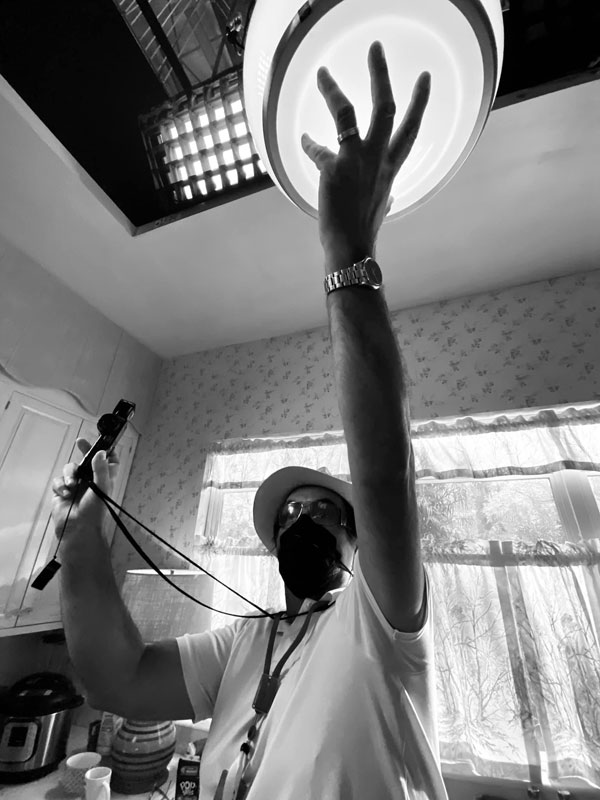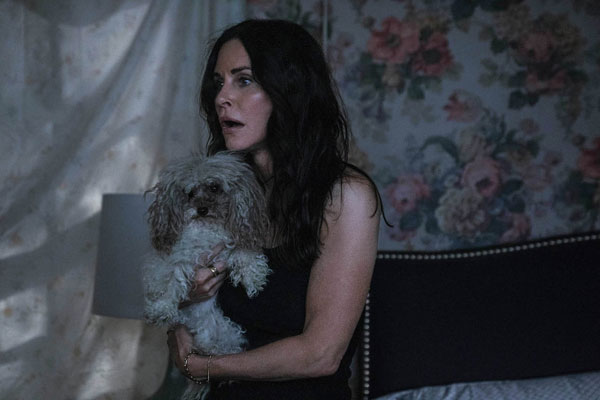NYFA Cinematography instructor Suki Medencevic studied cinematography in Prague, Czech Republic. There, he studied under the guidance of renowned cinematographers and artists from around Europe. Medencevic trained in a rigorous five-year program and shortly after he graduated, he made the move to the United States because he “felt that the United States would be a much, much better place for me, which proved to be true.” Medencevic’s credits include American Horror Story, Them, The Great Water and many more. His latest work Shining Vale, starring Courtney Cox, Mira Sorvino and Greg Kinnear is currently streaming on Starz.
Medencevic’s lighting strategy, collaboration with visual-effects supervisor Jason Piccioni, and the equipment used while on set for Shining Vale were captured in the May 2022 issue of American Cinematographer Magazine. The cinematographer achieved unique looks by introducing additional cameras in special cases. When discussing the tiki-bar scene, Medencevic said, “Lighting for the tiki-bar scenes had four different looks, depending on the scene and characters. The idea was to always keep the lighting ‘invisible,’ and make it look like the set is lit only by practical sources.”
Medencevic spoke with NYFA about filming horror-comedy, Shining Vale, the importance of preparation before and after getting the job, and collaboration on set.
NEW YORK FILM ACADEMY (NYFA): What did you learn on the set of Shining Vale?
SUKI MEDENCEVIC (SM): Oh, I learned a lot. The great thing about cinematography is that you can never say that you know it all. Every project is different. Every day is different. Shining Vale taught me to not be afraid to risk, to not be afraid to experiment and not to be afraid to have fun. Honestly, I had a lot of fun because of the subject of Shining Vale. The story, the script and the characters gave me a lot of opportunities to really push the limits and be really daring in terms of visuals. So be brave and have fun. That was what I learned on Shining Vale.
NYFA: What was the hiring process like for this job in particular? And how did you prepare for Shining Vale?
SM: So the way this works is normally you get a meeting based on your previous work or based on recommendation by your agent or somebody that you’ve worked with. I remember reading the pilot for Shining Vale initially and I absolutely loved it. I decided I would do everything I needed to do to really show that I was excited about the project – not only that I had ideas and a vision. Enthusiasm and excitement are very important to the people that are interviewing. They have to feel that you aren’t seeing this as another paycheck or another job. I remember spending three days doing research, getting visual elements and putting together a presentation book of about twenty-five pages of text and images – which is a lot of work when you think about it. And you’re doing it based on speculation, you’re presenting something which might not even be close to what they want. But I did it anyway.
It was probably the longest interview I ever had for any show. I think we spent maybe an hour and half talking and they really enjoyed the meeting and what I presented. But as it often happens for pilots, it ended up that the producer or actual director had somebody else that they worked with before that had become available. So I ended up not doing the pilot, which is OK. They were kind enough to let me know that they really enjoyed meeting me and that they liked my ideas, etc. But after the pilot was shot and done, a few months later, I received a call and they asked me if I would be interested in doing the series for season one. I guess the original cinematographer of the show was no longer available and they wanted to go back and give me a chance. And of course I said, ‘yes, I’m very much available and interested,’ and that’s how I got on board.

Suki Medencevic working on the set of Shining Vale.
NYFA: What would you say is most different about the field of cinematography today from when you first started?
SM: I would say the last ten years have seen the most dynamic changes because digital technology became widely embraced on both acquisition and distribution sides. Prior to digital technology, a cinematographer was kind of like a magician. It’s magical shooting on film and I still love shooting on film. It actually brings a level of excitement and a level of anxiety that is necessary when you are creating images. With film, you’re exposing some photochemical elements inside the emulsion that you can only see when you have your final result. So there is this big moment of anticipation. Nobody on set knows what’s really happening when you take a light meter, do the reading, put the color, put the diffusion and do the things that cinematographer do with film. So, then, nobody would question it or have any opinion. But with digital cameras there is the instant gratification of viewing your images on the monitor, you’re seeing it immediately. Not only you, but everybody’s seeing and it kind of demystifies what you do. And it also gives people the right to an opinion.
The discipline of filmmaking has completely changed. Before, you didn’t have too many chances to get it right. The shot had to really be the right shot and you wouldn’t do 20 takes because you just couldn’t. There is the economic aspect: film is not cheap; and if you know that, you get 3 good takes and move on because you have to. Shooting on digital changes things quite a bit. The directors know that you can just change the card and keep shooting. So instead of shooting less, you are all of a sudden shooting more because you can and because you shoot more, the days are longer. You very often shoot things that you don’t necessarily need, but you do because you can.
However, the biggest technological advancement has been, I would say, the advancement in camera and chip technology. We now have cameras that are so sensitive that it makes it much more nimble when it comes down to lighting. However, you still need to light. Just because you’ve got a camera with higher sensitivity to the light, does not mean that you’re just going to turn on the camera and keep shooting because you can capture the image. As a cinematographer, you need to be in control of the image, the image needs to be properly lit. No matter what happens with technology in the future, we will still use light. The cinematographer will still set the lights, illuminate the scene, and make sure the light is the way it should be otherwise we’re doing a documentary.
NYFA: How do you approach your work as a teacher?
SM: Teaching was always something that I had a passion for. I find it very stimulating as a teacher to share ideas and also get feedback from my students about things that I talk about. Cinematography is craft and it’s art at the same time. So I try to encourage my students to learn the craft in order to apply it towards the arts so that they can explore it and find their own language, find their own vision.
In order to be a really good cinematographer, you have to be very well-trained because a cinematographer’s job is to interpret the text that is in the script. So you have to find the visual language and preferably not have a style and always do what works for the story. I encourage my students to sharpen their skills, understand and observe things around them and try to memorize and capture the moments; to be photographers, even if it means just carrying your cell phone in your pocket. If you see something interesting – capture the image. I encourage my students to be constantly active and also learn from the other cinematographers.
You’re not only a cinematographer when you are on a movie set and setting lights and making images, you’re a cinematographer 24 hours a day.

A still of Courtney Cox in Shining Vale
One thing I want to add, is how important it is and why it is important to know how to light a face, how to properly light the actor or actress. In Shining Vale, the three main characters are Courteney Cox, Mira Sorvino and Greg Kinnear and they are amazing actors. They’re beautiful people but you still have to light your actors in the most flattering way. If anyone reading takes anything away from this, let it be that moody lighting doesn’t mean turning off the light to let things go dark. Even in the darkest darkness, you have to light. You have to know how to light for darkness. Make a scene moody by using light, and especially when you have high paid talent on the set. So I would say if you want to be a cinematographer and really, really do well learn how to light your main actor or actress because that is something that hasn’t changed from the early days of Hollywood.
NYFA: What was the collaborative experience like on Shining Vale? Did you work with the set designer or anyone else to bounce ideas off of?
SM: I can tell you, this is a truly important question and a very important thing for students to know.We weren’t using a real house for logistical reasons so the only option was to build a house on a stage. We did it using 3 sound stages at Warner Brothers Studios. The production designer Jeff Sean and our creative department did a great job of reconstructing a massive Victorian style house on a stage and making it look as real as possible. The realism that they were going for in the art department with set dressing and set decoration was key for my lighting concept. I decided to start much earlier than normally. I started my prep on my own, on my own time. But having conversations about the set construction with the production designer early on, before they even started putting one single wall up, was so important because I would give my input in terms of how the walls should be treated and the colors of the walls. The ceiling was also an important aspect of the whole set building because I did insist that every set have a solid ceiling so that we could look up and see that the place was real. And even though it made it limiting for me as a cinematographer to light, it made it look more believable for the show. So because of the conversations I had: what type of lights we should have, what type of practical sources, what type of shades we would have on all these lights in the house, there were no surprises. I really benefited from the whole process. When I showed up on the sets I knew exactly the tonality, the reflectivity of the floor, of the walls, of the tiles, everything had been tested.
As a cinematographer, you have to be proactive because the cinematographer is usually one of the last people to get hired. If there is no early conversation with the production designer then when you get to the set, it’s too late to make changes and then you have to work around what has already been made.
The New York Film Academy congratulates NYFA Cinematography instructor, Suki Medencevic on his work on Shining Vale. We look forward to seeing more of his work!